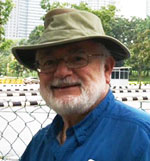Tasting the Past, The Science of Flavor & the Search for the Original Wine Grapes by Kevin Begos. Algonquin Books of Chapel Hill, ISBN 9781616-205775, 277 pages, $26.95
By Oliver B. Pollak

RICHMOND, California — Kermit Lynch Wine Merchant in Berkeley was the 2nd stop on a three-week, nine-event book tour traversing Florida, California and New York. I asked author Kevin Begos if his book will appeal to Jewish readers. The question elicited an OMG reaction, “at least half the book focuses on the Middle East.” Wine is mentioned in Genesis, Exodus, Leviticus, Numbers and Deuteronomy.
As a freelance journalist, his science beat included solar energy and North Carolina’s sterilization program. In 2008 he received the first English language Arab Science Journalism Award for reporting on cancer survivorship in the Middle East. In 2011 he “received a life-changing fellowship” studying surf clam DNA at Marine Biological Laboratory in Woods Hole, Massachusetts.
Kevin’s wine odyssey started in 2008, in an Amman, Jordan hotel room. His mini bar contained a bottle of Cremisan dry red wine from the Bethlehem Salesian Roman Catholic monastery. He had never heard of the wine and resisted opening it. He succumbed and was surprised, dumbfounded and infatuated by the bottle’s delightful contents. He searched for years to get another bottle. When he found a bottle it did not taste the same. “My memories had crashed into reality.” The wine maker responsible for the vintage Begos drank died and left no blending notes. An Italian consultant stopped using concrete vats. In 2016 Yotam Ottolenghi, internationally renowned Israeli chef, London restaurateur and cookbook author, while preparing “A feast for ‘Jerusalem’ at the Met.” related as a child his “father took him to the monastery for a memorable tour of the winery.”
Many factors influence taste, flavor and aroma including terpenoids, resveratrol, rotundone, antioxidants, phenolics, variety of grape vine, age of vine, soil, rainfall, temperatures, drought, microbes, nematodes, sugar content, additives, rock, clay, yeast, wood, stainless steel, and plastic vats. He succinctly summarizes the debate over Terroir, whether you can taste soil and rock formation. Although an Index would have been helpful, there is a bibliography.
Begos is concerned about the reliance on Chardonnay, Merlot, Cabernet Sauvignon, Pinot Noir, Rieslings, and Sauvignon Blanc, produced at “prodigious flavor factories” designed “to offend the least number of people.” It narrows wine grape biodiversity and threatens the existence of small heritage producers. Wine Grapes, a census by Jose Vouillamoz, Janis Robinson and Julia Harding published in 2012 lists 1,368 varietals, a number that is sure to rise, despite extinctions.
Artifacts include ancient grape skins, seeds, pips, stems, fermentation vats, drinking cups made of animal horns, clay storage jars, qvevri, and pollen. “Grubbing up” (uprooting vines), and the disappearance of small vineyards include the 2-3 acres that grew Malvasia in Milan given to Leonardo Da Vinci in 1497 for painting the Last Supper. Begos suggests its more likely that Jesus and his disciples sat on floor cushions than at a table.
Mapping DNA vineyard ancestors, identifying genetic heritage, a family tree, involves archeobiology, biomolecular archeology, paleobotany, ampelography (identification and classification of grapevines, lianas that climb and cling), neuroenology, liquid chromatography, mass spectrometry, all words that challenged my spell checker. The $300-billion-dollar global market uses space age technology. Satellites measure plant emissions related to ripeness with a specificity of every few square feet.
“Everybody wants their country to be first.” The Jewish National Fund, the Blue Box Tzedakah tree planting people, funded an analysis of Israel’s wine and table grapes. Recent Israeli DNA investigation seems to place the “mother grape” somewhere 8,000 to 10,000 years ago in Georgia in the Caucasus Mountains from where seeds and cutting spread to the Middle East. hence the blessings,
He was driven by wanting “new flavors and different stories.” He visited 7 countries and the Palestinian Territories. This fascinating informative book explain science and wine in a way that neophyte enologists and non-science readers, and specialists alike will benefit. It may cause readers to drink with a deeper knowledge, appreciation and enjoyment of a 10,000-year practice, and to read further books such as Divine Vintage, Following the Wine Trail from Genesis to the Modern Age (2012) by Randall Heskett and Joel Butler.
Begos maintains an informative conversational tone and includes juicy historic poetry and prose about wine from the Epic of Gilgamesh, the Bible, Herodotus, Rumi, Omar Khayyam, Thomas Jefferson, Henry James, Ernest Hemingway, and many others. He acknowledges Adventures on the Wine Route (1988) by Kermit Lynch, a purveyor of small French and Italian wineries.
Consistency inhibits the “possibility of greatness, or surprise, or originality.” The appreciation of ancient-style winemaking, native grapes and experimentation parallels the rise of microbreweries, and the affection for single malt and single barrel potions. The next time you buy wine for Shabbat or Passover consider combining Borei pri Hagafen, fruit of the vine, with an Israeli wine with an ancient pedigree. Joining the search for old vines will lengthen your amphorae list.
*
Pollak, a professor emeritus of history at the University of Nebraska Omaha, and a lawyer, is a freelance writer now based in Richmond, California. He may be contacted via oliver.pollak@sdjewishworld.com
866